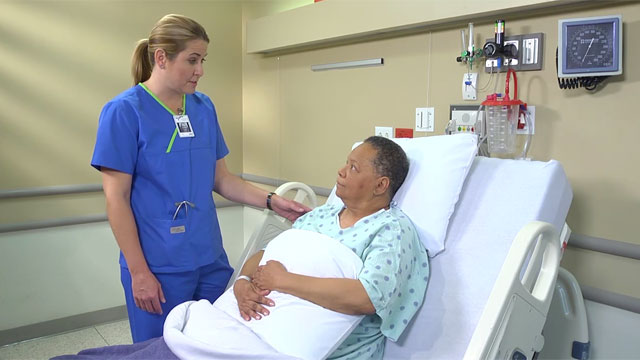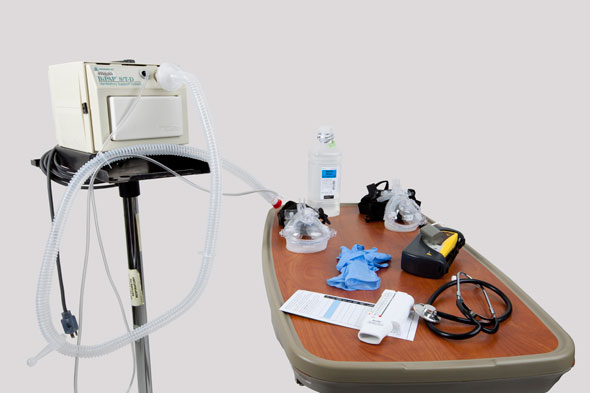Respiratory Care and Suctioning
Select a Skill:
- » Ensuring Oxygen Safety
- » Setting Oxygen Flow Rates
- » Applying a Nasal Cannula or Face Mask
- » Maintaining an Airway
- » Providing Tracheostomy Care
- » Performing Oropharyngeal Suctioning
- » Performing Nasotracheal and Nasopharyngeal Suctioning
Take the Review Test:

Safety
- Use specific side-lying positions, as ordered, for a patient recovering from a lobectomy or certain other types of thoracic surgery. Other positions may be contraindicated.
- Be alert for sudden changes in vital signs, level of consciousness, or behavior, which may signal profound hypoxia. Subtle changes over time may indicate worsening of a chronic or existing condition or development of a new condition.
- For a patient currently receiving noninvasive ventilation, determine if it is meeting the patient’s oxygenation and ventilation needs. If not, determine what factors have changed.
- When CPAP or BiPAP begins, monitor arterial blood gas levels and pulse oximetry measurements to detect carbon dioxide retention, especially in a patient with chronic obstructive pulmonary disease (COPD), pulmonary edema, or acute respiratory failure.
- For CPAP or BiPAP administration, wear gloves. Also wear goggles and a barrier gown if secretions are likely to splatter.
Equipment
(Roll cursor over items to see labels)

Stethoscope
Pulse oximeter
C-PAP/Bi-PAP machine
C-PAP face mask
Bi-PAP face mask
Bi-PAP tubing
Peak flow meter
Peak flow meter diary
Sterile water
Clean gloves
Delegation
The skills of respiratory assessment and caring for a patient receiving noninvasive ventilation may not be delegated to nursing assistive personnel (NAP). The task of follow-up peak expiratory flow rate measurement (PEFR) may be delegated to NAP. Be sure to inform NAP of the following:
- Explain the need to immediately report to you any changes in the patient’s pulse, blood pressure, respiratory rate, oxygen saturation, mental status, or skin color.
- Instruct NAP on how to modify care, such as how long the mask can be removed, how to provide oral care, and how to accommodate any special skin care needs.
- Review the prescribed settings on the NIPPV equipment, and emphasize the need to notify you of any change in settings or in the patient’s comfort level.
Preparation
- Assess the patient’s respiratory status, including the following:
- Symmetry of chest wall expansion
- Chest wall abnormalities, such as kyphosis
- Temporary conditions that affect the patient’s ventilation, such as pregnancy or trauma
- Respiratory rate and depth
- Sputum production
- Lung sounds
- Signs and symptoms associated with hypoxia
- Observe the patient’s skin over the bridge of the nose, around the external ears, and at the back of the head.
- Assess the patient’s ability to clear and remove airway secretions.
- Obtain pulse oximetry results, and note the patient’s most recent ABG results when available.
- Obtain the patient’s vital signs and pulse oximetry reading before initiating therapy.
- Review the provider’s orders in the patient’s medical record for CPAP/BiPAP to determine appropriate settings.
- Explain to the patient and family the purpose of and reasons for CPAP/BiPAP.
Follow-up
- Observe for decreased anxiety; improved level of consciousness and cognitive abilities; decreased fatigue; absence of dizziness; decreased pulse, regular rhythm; decreased respiratory rate and work of breathing; return to normal blood pressure; and improved color.
- Monitor for gas exchange—observe the patient’s pulse oximetry.
- Observe the skin integrity over the bridge of the patient’s nose.
- If NIPPV is planned for use in the home, observe and monitor the patient and family’s ability to manipulate the device and face mask.
- Observe a return demonstration by the patient and family to determine if they are using the correct technique with the PEFR.
- Monitor the PEFR with changes in therapy, and compare PEFR measurements with the patient’s personal best.
Documentation
- Record respiratory assessment findings, CPAP/BiPAP settings, vital signs and pulse oximetry, patient response, and patient teaching outcomes.
- Report to the charge nurse or the health care provider any sudden change in the patient’s respiratory status or any decline in ABG levels or pulse oximetry values.
- Document the patient’s PEFR measurements.
Review Questions
1. What would the nurse do first to ease breathing for a patient with mild dyspnea?
 Administer oxygen at 2 L/min by nasal cannula.
Administer oxygen at 2 L/min by nasal cannula. Help the patient into an upright sitting position.
Help the patient into an upright sitting position. Monitor the patient’s pulse oximetry level.
Monitor the patient’s pulse oximetry level. Determine if the patient has a history of respiratory pathology.
Determine if the patient has a history of respiratory pathology.
2. During an admission interview, a patient who is required to stay in the supine position reports, “I can’t breathe well while I’m lying down.” What would the nurse do first to help this patient?
 Notify the health care provider of the patient’s complaint.
Notify the health care provider of the patient’s complaint. Request that the health care provider prescribe oxygen therapy.
Request that the health care provider prescribe oxygen therapy. Interview the patient concerning the onset of this problem.
Interview the patient concerning the onset of this problem. Instruct the patient to use two bed pillows when lying supine.
Instruct the patient to use two bed pillows when lying supine.
3. The nurse is caring for a patient who is recovering from a left partial lobectomy. Which action would be most helpful in re-expanding the affected lung?
 Placing the patient in a right side-lying position
Placing the patient in a right side-lying position Encouraging the patient to deep breathe and cough every hour
Encouraging the patient to deep breathe and cough every hour Regularly assessing the patient’s ability to breathe comfortably
Regularly assessing the patient’s ability to breathe comfortably Providing medication to manage postoperative pain of greater than 3 on a 0-to-10 scale
Providing medication to manage postoperative pain of greater than 3 on a 0-to-10 scale
4. What is the purpose of splinting the abdomen with a small pillow during controlled coughing?
 To minimize chest discomfort caused by the coughing
To minimize chest discomfort caused by the coughing  To expand lung capacity during the inspiratory phase of the cough
To expand lung capacity during the inspiratory phase of the cough To maximize transdiaphragmatic pressure during the expiratory phase of the cough
To maximize transdiaphragmatic pressure during the expiratory phase of the cough To focus the patient’s attention on the abdominal muscles used during the cough
To focus the patient’s attention on the abdominal muscles used during the cough
5. What would the nurse do routinely to monitor oxygenation in a patient receiving BiPAP?
 Assess the patient’s level of consciousness every 4 hours.
Assess the patient’s level of consciousness every 4 hours. Monitor the patient’s pulse oximetry readings.
Monitor the patient’s pulse oximetry readings. Verify the pressure settings for both inspiratory and expiratory pressure.
Verify the pressure settings for both inspiratory and expiratory pressure. Evaluate daily arterial blood gases (ABGs)
Evaluate daily arterial blood gases (ABGs)
You have completed the Review Questions for this skill. To take the Review again select the Start Over button. To proceed to another skill select from the dropdown menu. Select the Home or Back button to proceed to the next section.

